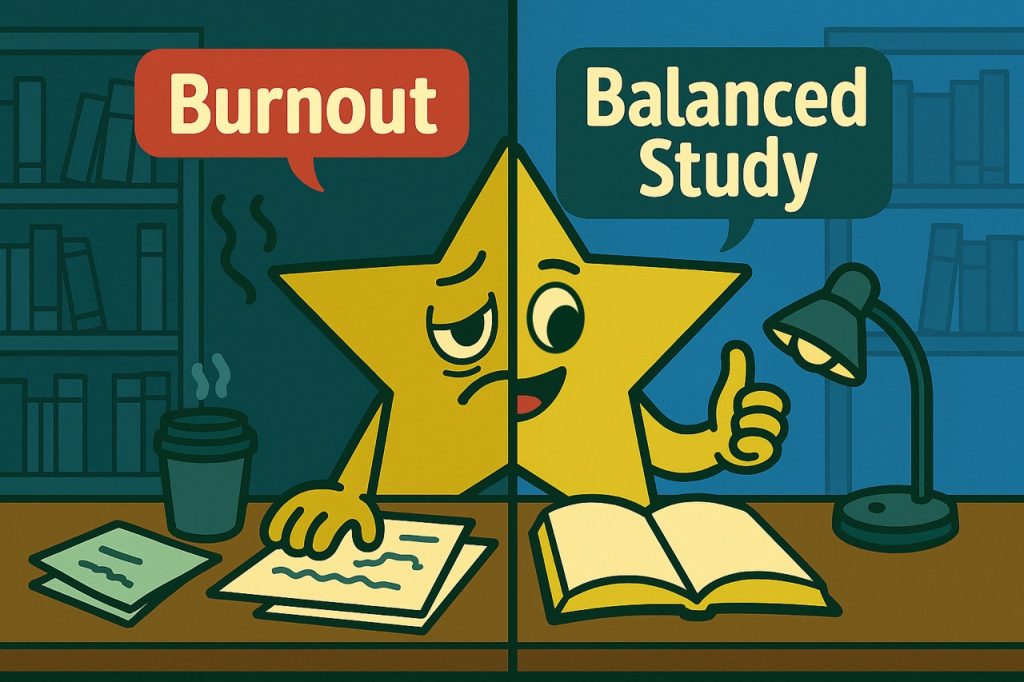
- Study tips
- 6 min read
- September 22, 2025
What study burnout looks like, and why it is rising
Academic burnout is common Recent research in higher education finds that stress and burnout among students are widespread, and in some contexts their prevalence exceeds that of the working population. Burnout is linked to impaired health and increased risk of dropping out, while study engagement is protective. These findings reinforce what many students and tutors see each term: long hours alone do not translate into better outcomes when energy and motivation collapse. Mental health trends offer a mixed picture Large annual surveys suggest that some indicators have improved in the last year, with declines in reported depression and suicidal ideation among college students, alongside increased access to support. Progress is real, yet many students still report significant psychological distress and pressure, so prevention during exam periods remains essential. What burnout feels like day to day- Constant fatigue and trouble concentrating, even after “studying” for hours.
- Irritability or indifference toward coursework you used to enjoy.
- Endless cycles of rereading and highlighting without recall.
- Procrastination, then frantic cramming that does not stick.
- Sleep disturbances that make the next day even harder.
Study less, score more: the science behind efficient learning
Active recall beats passive review Self testing, practice questions, and explaining answers out loud strengthen memory more than rereading. The testing effect is robust across age groups and subjects. Frequent low stakes retrieval makes learning stick without extra hours. Spaced repetition multiplies results Instead of cramming, spread practice across days. A major meta analysis covering hundreds of experiments shows that distributed practice significantly improves retention compared with massed study. Space your sessions, and you can study less total time for higher recall. Low stakes quizzes reduce anxiety, raise performance Formative assessment, especially frequent low stakes quizzes with feedback, is associated with improved learning outcomes in higher education. Students get earlier signals about what to fix, which reduces panic before high stakes exams. Lecturers also get insight to target support. Time management is a skills multiplier Meta analytic evidence links concrete time management behaviors like planning and prioritization with better grades and engagement. Clear weekly plans reduce decision fatigue, free up attention for actual learning, and buffer stress. Sleep is not a luxury, it is a study strategy While effect sizes vary across studies, the direction is consistent: better sleep supports learning, attention, and mood. Treat sleep like a scheduled lab: fixed start time, fixed end time, and no last minute cancellations. Your next day’s study quality depends on it.Practical study hacks that protect your energy
1: Build a weekly “exam rhythm” instead of daily marathons- Pick four focused study blocks of 50 to 60 minutes per day, five days per week.
- Assign each block to one course or one topic cluster to avoid context switching.
- End every block with a 5 minute wrap up: write a one sentence summary and list one confusion to revisit.
- Start with a quick brain dump of everything you remember about a topic, then check gaps.
- Move to short answer prompts, then mixed practice questions that force discrimination.
- Finish with a “teach back” to a friend or to your phone recorder. Explaining exposes illusions of knowing.
- Rotate topics across days to let forgetting begin slightly before you restudy, which strengthens memory when you retrieve again.
- Interleave similar problem types, for example different derivative rules or different case analyses, so you practice choosing methods, not just executing them.
- Create or source two to five low stakes questions for each lecture as soon as you finish it.
- Schedule a weekly “quiz hour” to cycle through missed items, then tag anything you still cannot retrieve for next week.
- Plan no more than 70 percent of your waking hours. Leave room for delays, meals, and recovery.
- Batch admin tasks like emails, calendar updates, and forms into one short block to protect deep work. Evidence connects structured time use with higher engagement and performance.
- Fixed bedtime and wake time, even on weekends.
- Cut off caffeine 8 hours before bed, and screens 60 minutes before bed. Reviews link insomnia symptoms and stress, so your sleep routine is part of your study plan.
- Short walks, light exercise, and friend check ins are active recovery that stabilizes mood and sharpens attention for your next block.
- Label emotions briefly on paper: “anxious about topic X,” then choose one action. Naming reduces rumination.
Save hours with AI, without sacrificing judgment
AI can reduce study time when used for process, not replacement Early studies and institutional pilots suggest that AI assistants can cut the time students spend on routine study tasks. For example, one university reported a 27 percent average reduction in study time among distance learners using an AI learning assistant, primarily by automating summaries and practice question generation. Treat these tools as accelerators for the parts of studying that do not require your unique reasoning. Emerging academic work points in the same direction: students report time savings and in some cases improved grades when AI is used to scaffold learning and personalize practice. The benefits come with caveats: over reliance can backfire, and integration with existing habits matters. Use AI to draft, not to decide, and always verify. Practical AI workflows that respect student mental health- Lecture to outline in minutes: paste lecture notes into an AI and ask for a concise outline with key concepts, definitions, and 5 comprehension questions. Review, correct, and then study from your version.
- Auto generate active recall prompts: convert sections of your notes into short answer questions, then export them to a quiz deck. Retrieval beats rereading, and AI speeds the setup.
- Versioned notes for less chaos: keep a running changelog for each topic so you can roll back to the last clean state, compare versions, and share stable snapshots for group study without fear of overwrite.
- Smart scheduling: ask AI to translate your syllabus into a spaced study plan with topic rotations and weekly quiz sessions. Cross check against your calendar before you commit.
- Always verify technical steps, formulas, and citations by checking your textbook or trusted sources.
- Use AI to simplify wording, not to invent content for graded work without permission.
- Keep a “why I agree” note for every AI suggestion you adopt. If you cannot explain it, do not include it.
What lecturers wish you knew about learning
Frequent, low stakes practice is built to reduce anxiety Reviews of formative assessment in higher education conclude that low stakes quizzing and timely feedback tend to improve learning when implemented thoughtfully. This approach helps you catch misconceptions early and steadily build mastery, which lowers exam stress. It also gives lecturers signals to adjust teaching before the final. Office hours are undervalued, and they compound Studies and institutional reports consistently note that office hours are underused, yet design choices like timing, format, and communication can increase attendance and perceived value. A short visit to check your understanding early can save multiple frustrated hours later. Treat office hours as part of your weekly system, not a last resort. When you come prepared, feedback goes further Lecturers are most effective when you bring a specific question, a failed attempt, or a one page summary of what you understand and where you got stuck. This turns office hours into targeted study sessions with strong returns. Pilot work and teaching center guidance point to measurable benefits when office hours function this way.A 7 day reset to cut hours and recover focus
Day 1: Audit and subtract- List all topics and deadlines. Circle the 20 percent that drive 80 percent of your grade.
- Identify two low value commitments to pause for two weeks. Protect your bandwidth.
- Map four daily study blocks across five days. Assign topics to each block. Add a nightly quiz slot.
- Set bedtime and wake time alarms. Treat sleep like a lab to stabilize mood and memory.
- For each lecture, generate 5 to 10 short answer questions. Use AI to draft, then you edit for accuracy.
- Create a deck for each course and schedule spaced review across the week.
- Mix practice across similar topics. Force yourself to choose the right method, not just apply one you just saw.
- End with a 20 minute low stakes quiz and immediate feedback. Track mistakes and tag for tomorrow.
- Bring one page: what you know, what you tried, where you got stuck. Ask for the smallest next step.
- Book your next check in before you leave to maintain momentum.
- Run a timed practice. No notes, no phone. Grade yourself using the mark scheme where possible.
- Write a short reflection: one concept to relearn, one careless error to prevent, one strategy that worked.
- Take a half day off from study. Move your body, see a friend, and sleep.
- Preview next week’s plan for 15 minutes. Small glimpses reduce anticipatory stress.
Where an all in one AI native study workspace fits
If you want one place to tie this together, modern study apps can help. For example, Blekota gives you an all in one AI native study workspace with an AI chat and agent that can help you understand material or create study materials like flashcards, practice tests, notes, and oral exam scripts. You can turn lectures into question banks for active recall, version control your notes to avoid chaos during group work, and auto build spaced review plans that support student mental health during peak stress. There is a free week trial, so you can try it without risk and keep what helps. Use it as one option among many, and always keep your judgment on top.Common pitfalls to avoid when cutting study hours
Replacing thinking with tools AI can summarize and generate prompts quickly, but it cannot do your learning. Always retrieve from memory before you read an answer. If you are not effortfully recalling, you are not training the skill that the exam measures. Swapping quantity for chaos Reducing hours without structure increases stress. Keep a simple plan: four focused blocks per day, weekly quiz sessions, and nightly shutdown. Time management behaviors correlate with better academic outcomes because they reduce noise. Ignoring sleep and basic needs When sleep collapses, everything else gets harder. Build your schedule around sleep first, then study. Protecting sleep is both a mental health decision and an academic one.Expert and lecturer aligned checklist
- Use active recall and spaced repetition across the whole term.
- Prefer frequent, low stakes practice with feedback over rare, high stakes cramming.
- Plan your week, not just your day. Batch admin tasks and protect recovery time. }
- Use office hours early, with specific questions and attempts.
- Let AI automate busywork like summarizing and question generation, then verify and edit.
Conclusion: less time, more learning, better wellbeing
Studying less and scoring more is not a paradox when you switch from hours based studying to learning based studying. Active recall, spacing, and low stakes quizzes are the backbone. Simple time blocking protects your attention, sleep stabilizes your memory, and AI clears the busywork. Together these choices reduce study burnout and support student mental health without sacrificing results. If you want a single workspace to put this plan on rails, explore tools like Blekota. It is an all in one AI native study workspace with chat and agent features that help you turn lectures into practice and keep your notes version controlled, and you can try it free for a week. Keep using what measurably reduces your stress and raises your recall. Your grades and your wellbeing can improve together.University life asks you to learn quickly, remember reliably, and apply ideas under pressure. Good intentions are not enough. What works is a small set of science-backed strategies that turn raw effort into measurable progress. This guide explains seven techniques that consistently improve learning: what they are, why they work, and exactly how to practice them.
Everything here favors simple routines you can actually keep. You will find concrete examples, step by step workflows, and a lightweight weekly plan you can plug into your calendar today. Whether you are preparing for finals, language exams, medical boards, or your next quiz, these methods will help you study less and remember more.
If you want a digital workspace to pull these habits together, there are many options. You can use paper, spreadsheets, or a study app for college students like Blekota. Later in this guide you will also see how to practice with all-in-one tools that create flashcards, tests, and notes from your materials. First, let us master the methods.
Quick overview of the 7 techniques
- Active Recall: quiz yourself from memory, not by rereading.
- Spaced Repetition: revisit material on a smart schedule before you forget it.
- Blurting: close the book, write everything you remember, then compare.
- Traffic Light Method: tag topics as green, yellow, red to focus your time.
- Interleaving: mix problem types or topics within a study session.
- Dual Coding: combine words and visuals to strengthen memory.
- Elaborative Interrogation: ask why, how, and what if to deepen understanding.
Below you will find detailed instructions and examples for each method, plus where to practice them effectively.
1) Active Recall
What it is
Active recall means retrieving information from memory without looking at your notes. Instead of rereading chapters or highlighting, you turn each idea into a question and force your brain to answer. Retrieval strengthens memory far more than passive review. It also exposes gaps you can fix early.
Why it works
Memory forms through effortful retrieval. When you pull an answer from your head, you re-encode that knowledge, making it easier to recall next time. Over time, questions build a durable network of cues: definitions, examples, diagrams, and contrasts that point back to the same concept.
How to do it step by step
- Read a small section first, then close your notes.
- Write 3 to 5 questions in your own words, for example: define, compare, apply, explain why.
- Answer out loud or on paper without peeking.
- Check the answer, correct mistakes, and record only the minimal hint you need next time.
- Repeat across sections, then run a quick self-quiz of all questions at the end.
Common mistakes to avoid
- Turning questions into mini essays. Keep them short and testable.
- Peeking too soon. Struggle a bit first, then check.
- Quizzing only definitions. Add why, how, and example questions to build transfer.
Where to practice
Index cards or a simple flashcard app are perfect. Many students like digital flashcards, an AI flashcard generator, or a flashcard maker that lets you convert notes to flashcards and create flashcards from PDF. Blekota is the perfect app for flashcards, as it can do all of these. A spaced repetition app amplifies active recall by scheduling reviews for you, which you will see next.
2) Spaced Repetition
What it is
Spaced repetition means reviewing information at increasing intervals, just before you are likely to forget it. Instead of cramming, you spread small quizzes over days and weeks. The spacing effect improves long term retention with less total study time.
Why it works
Forgetting follows a curve. If you test yourself right before the curve dips, the memory rebounds stronger. Each well timed review lengthens the interval you can go without forgetting. Over a semester, spaced sessions beat marathon cramming every time.
How to do it step by step
- Build concise prompts: term, concept, formula, diagram labels, short cases.
- Review Day 1, Day 3, Day 7, Day 14, then monthly. Adjust if items feel too easy or too hard.
- Mark items as easy, medium, or hard. Increase gaps for easy items, shrink gaps for hard ones.
- Keep sessions short, 10 to 20 minutes, but frequent.
Common mistakes to avoid
- Overwriting the same long note. Use bite sized prompts you can answer in seconds.
- Skipping hard cards. The system only works if you face difficult items on schedule.
- Confusing rereading with review. Always retrieve before you look.
Where to practice
You can use a paper calendar, a spreadsheet, or a spaced repetition app like Blekota.
3) Blurting
What it is
Blurting is a rapid recall drill. You close your materials, set a short timer, and dump everything you can remember on a topic. When time is up, you compare your blurt to the source, fill gaps, and repeat until your write up covers the essentials cleanly.
Why it works
Blurting turns passive familiarity into active retrieval. The blank page forces you to reconstruct structure: definitions, relationships, steps, exceptions. You quickly learn which parts are solid and which parts collapse under pressure, just like in an exam.
How to do it step by step
- Pick a topic, for example: cardiac cycle, Krebs cycle, supply and demand shifts, subjunctive mood.
- Set 5 to 10 minutes. No notes, no slides.
- Write headings first, then fill details, examples, and typical questions.
- Compare to your source. Highlight missing points in a different color.
- Do a second blurt. Aim for clarity and hierarchy, not verbatim recall.
Common mistakes to avoid
- Copying from notes and calling it blurting. The value comes from memory, not transcription.
- Writing a wall of text. Use headings, bullets, arrows, and simple diagrams.
Where to practice
Any plain text editor or notebook works. You can save your blurts inside a study app for college students, then turn your headings into online flashcards. Some tools let you create flashcards from notes with one click, a helpful shortcut for repeated recall.
Start studying smarter
Unlock your full academic potential.
Blekota helps you organize notes, create effective flashcards, and prepare for exams with confidence.
Unlock your full academic potential. Blekota helps you organize notes, create effective flashcards, and prepare for exams with confidence.
4) Traffic Light Method
What it is
The traffic light method is a simple triage system. You tag topics as green, yellow, or red. Green means you can teach it to a friend. Yellow means you kind of know it but make mistakes. Red means you need focused help. Your study plan then prioritizes red first, yellow second, and green last.
Why it works
Students lose time by treating all material equally. The traffic light method channels attention where it matters. It also gives a visual snapshot of progress, which is motivating and clarifies what to review the night before an exam.
How to do it step by step
- List chapters, learning outcomes, or exam topics.
- After a short quiz or blurt, assign each topic a color.
- Schedule daily 20 minute blocks only for red topics until they turn yellow.
- Move yellow topics into interleaved practice sets. Review green items weekly.
Common mistakes to avoid
- Keeping colors fixed. Update colors after each quiz to reflect reality.
- Hiding red topics. Put them at the top of your plan and celebrate when they change.
Where to practice
A whiteboard, sticky notes, or a simple Kanban board works. In digital tools, add tags like red, yellow, green to questions or cards.
5) Interleaving
What it is
Interleaving means mixing different problem types or topics in one session, instead of blocking your time by doing the same kind of question over and over. For example, you alternate derivative rules, then switch to integrals, then optimization, then back again.
Why it works
Real exams do not tell you which method to use. Interleaving forces you to choose strategies, not just execute them. Your brain learns to identify patterns, avoid look alike traps, and switch gears quickly. This improves accuracy and transfer to new problems.
How to do it step by step
- Pick 3 to 4 subtopics that students often confuse.
- Create a small set of questions for each, then shuffle.
- Work one question from each subtopic in rotation.
- After the set, write one sentence: how to spot each subtopic fast.
Common mistakes to avoid
- Mixing difficulty too wildly at first. Keep items comparable, then add harder ones.
- Abandoning interleaving too soon. It feels harder, but that difficulty is the learning signal.
Where to practice
Use a spreadsheet or a test prep app to shuffle mixed sets. If you already have GRE vocabulary flashcards, IELTS vocabulary flashcards, TOEFL vocabulary flashcards, or SAT practice flashcards, you can interleave by mixing word origins, synonyms, antonyms, and example sentences in one session. Medical or nursing students can interleave anatomy flashcards app topics or nursing pharmacology flashcards by mechanism, class, and side effects.
6) Dual Coding
What it is
Dual coding combines words and visuals. You pair a short explanation with a diagram, timeline, flowchart, mind map, or table. The two channels reinforce each other, giving your memory more routes back to the idea.
Why it works
Many concepts are hard to hold as text alone. Visuals expose structure: cause and effect, sequences, contrasts, and categories. When you later answer a question, either the words or the image can trigger recall of the full concept.
How to do it step by step
- Write a 2 to 3 sentence explanation in plain language.
- Choose a visual that fits the idea: process flow, tree, Venn diagram, or quadrant.
- Label only what matters. Avoid decorative clutter.
- Convert labels into short recall questions for later quizzing.
Common mistakes to avoid
- Overbuilding pretty diagrams. The goal is retrieval, not art.
- Adding visuals without alignment. Each element must answer a specific question.
Where to practice
Sketch on paper, then photograph your best diagrams to keep a clean record. In digital tools, pair each figure with online flashcards. Science students often add figures for organic chemistry flashcards app. Language learners can combine sentence patterns with mini flowcharts to show grammar choices, a trick that helps with Spanish practice using Spanish vocabulary flashcards AI.
7) Elaborative Interrogation
What it is
Elaborative interrogation means asking why, how, and what if as you study. You link new facts to prior knowledge, generate explanations, and test assumptions. The goal is not to memorize random facts, but to understand causes, mechanisms, and consequences.
Why it works
Understanding builds more durable memories than rote facts. When information sits inside a network of explanations and examples, you can retrieve it from many angles. This is essential for essay questions, case analysis, and oral exams where depth matters.
How to do it step by step
- After each paragraph, write one why question and answer it in a sentence.
- Generate two examples that are similar and one that is a counterexample.
- Create a quick compare and contrast table with neighbors in the same family.
- Finish with one transfer question: how would this change if X were different.
Common mistakes to avoid
- Writing long essays. Keep explanations short, then quiz them later with active recall.
- Staying at the definition level. Push to mechanisms, exceptions, and applications.
Where to practice
Use a notes app or paper and tag each why question. Later, transform them into a mixed quiz.
Putting it all together: a simple 4 week plan
Week 1: Build prompts, set colors
Create short active recall questions for each topic. Do one blurt per chapter. Tag topics with the traffic light method after a quick quiz. Start spaced repetition on Day 1 and Day 3. Keep sessions under 25 minutes with a short break, a rhythm many students already use.
Week 2: Interleave and explain
Mix similar subtopics. Add one dual coded diagram per chapter. For each tough idea, write a two sentence elaboration that answers why it works. Keep spaced reviews on Day 7 and Day 14 for all prompts built so far.
Week 3: Raise difficulty
Switch to exam style questions. Do a longer blurt from memory for entire units, 10 minutes each. Update traffic light colors. Red topics get daily 20 minute focus blocks. Interleave problem sets across chapters, not just within one chapter.
Week 4: Simulate the test
Run two cumulative self tests under time. Review only your misses. Do fast blurts with headings for each unit. Keep light spaced reviews to stabilize memory. Sleep and pacing matter more than cramming now.
Practicing with digital tools: from notes to quizzes in minutes
Turn content into questions quickly
The fastest way to build momentum is to convert your existing notes and PDFs into bite sized prompts. Many tools support PDF to flashcards and create flashcards from notes. If you learn best with cards, try a free flashcards app or a best flashcard app for students that fits your course. Language learners often prefer the best flashcard app for language learning, while med students pick the best flashcard app for medical students. Engineers and business majors may start with a test prep app or an AI quiz generator.
One option that unifies the workflow
You can practice all seven techniques inside an all-in-one AI native study workspace such as Blekota. It includes an AI chat and agent that can help you understand readings or create study materials: flashcards, tests, notes, and even mock oral exams. You can generate practice questions automatically, organize topics with traffic light tags, and run spaced repetition sessions from the same place.
Common questions
How do I balance active recall with reading new material
Split time roughly 60:40 during the semester: 60 percent on retrieval, 40 percent on intake. For a brand new unit, do a short read, then immediately switch to questions and blurting. Retrieval should dominate by the second pass.
Is cramming ever useful
Cramming can boost short term performance, but it fades quickly. If you must cram, combine it with active recall and interleaving, not rereading. Then move those questions into a spaced schedule so the learning sticks.
What if flashcards do not fit my subject
Many ideas still break into questions: compare two theories, outline a proof, label a diagram, explain a mechanism, list conditions. Use dual coding and elaborative questions to turn big ideas into testable prompts.
How do I use study groups effectively
Meet weekly. Start with 10 minute blurts, then each member teaches a red topic to the group. Finish with a mixed quiz. Online, you can share flashcards online and share study notes online to keep everyone aligned between sessions.
Conclusion
Students search for tools in different ways. If you are comparing options or looking for specific workflows, these phrases can help you discover what you need without wasting time:
Choose two techniques to start this week. Add the others over time. If you prefer an all-in-one digital workflow, try a study workspace like Blekota, which can generate flashcards, tests, structured notes, and mock oral exams from your materials, then schedule reviews for you.
Small, consistent steps compound. Set your timer, close the book, and start retrieving. Your future self will thank you.




